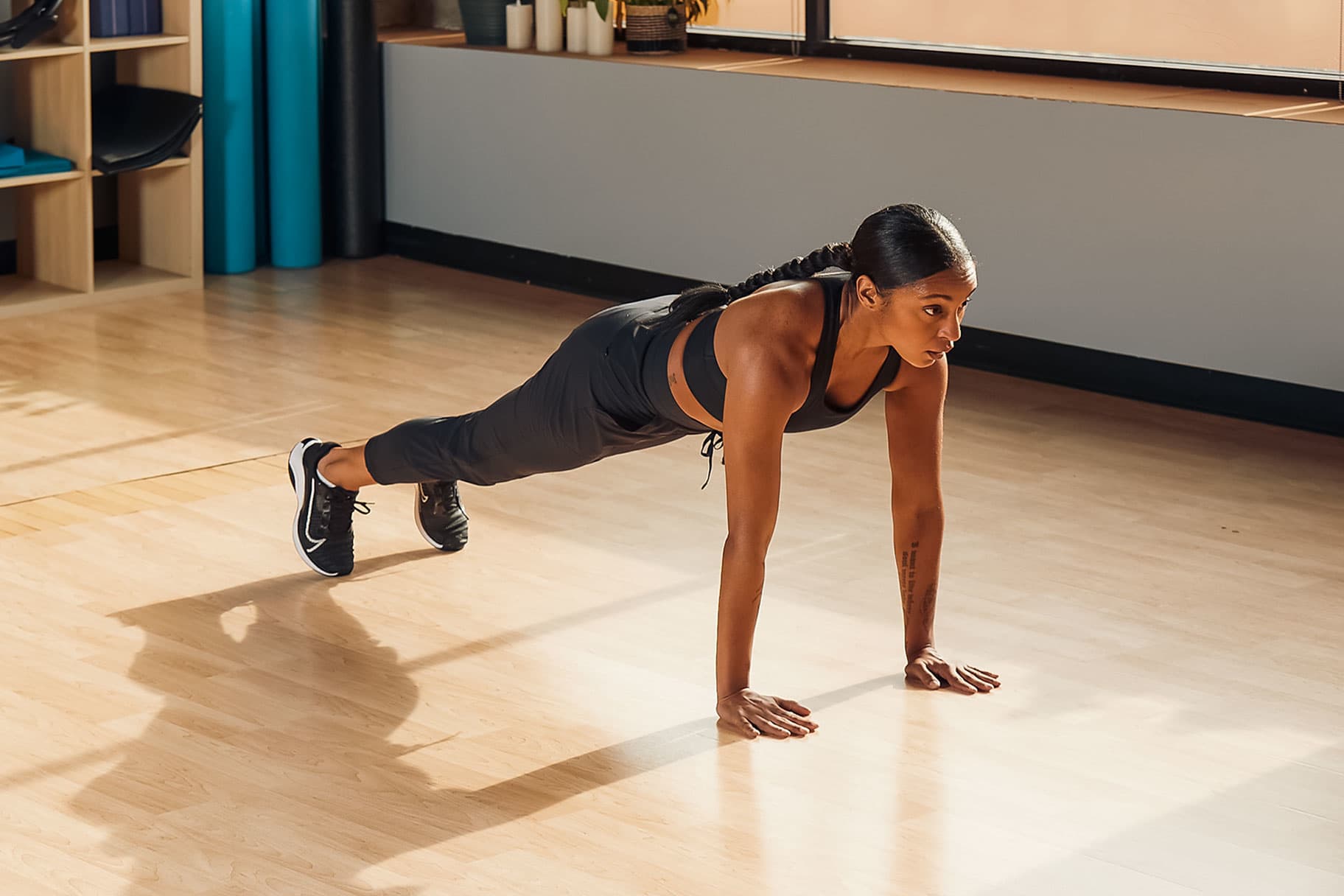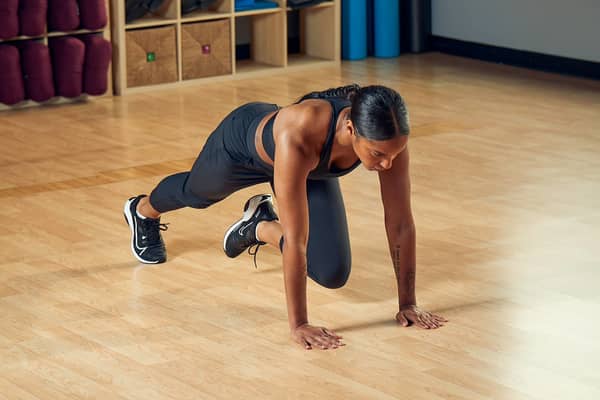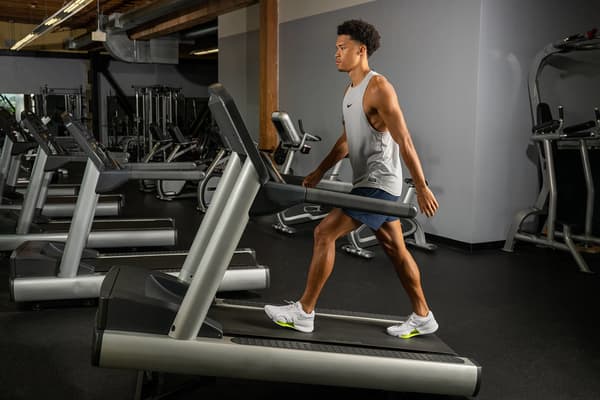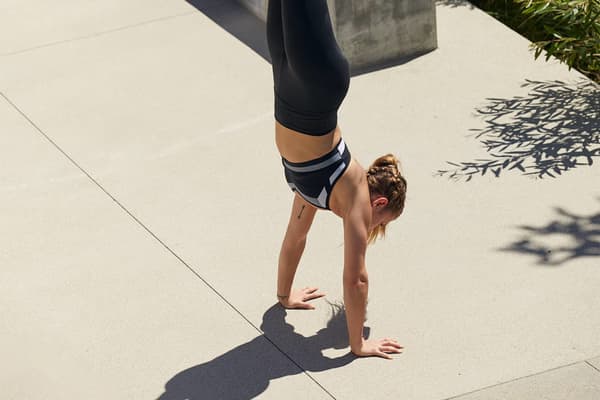A Beginner's Guide to Burpees, According To Personal Trainers
Sport & Activity
The explosive movement is the perfect combination of cardio and strength.

What is a burpee? If you're not familiar, burpees combine bodyweight planks, push-ups and squats. And they're usually performed quickly, frequently appearing in high-intensity interval training (HIIT) workouts for good reason. Burpees offer a host of health benefits, from plyometric to cardiovascular.
Given their intensity, burpees especially benefit the cardiovascular system. "Burpees get your heart rate up really fast because your body is making major level changes", said Julie Jones, a NASM-certified personal trainer. Level changes consist of repositioning the body to different heights and positions. In the case of burpees, level changes refer to going from standing to a plank position and then standing up again—which requires your heart and lungs to work harder than if you were to remain at one level.
And the benefits don't stop there. Given the technique and moves included in the exercise, you can score a full-body workout when you do a burpee.
Burpees involve three main movements:
- Squat and lower
- Plank
- Stand from the ground
Together, the movement activates your quads, glute, hamstrings, core, shoulders and back, said Gabbi Berkow, R.D., an exercise physiologist and NASM-certified personal trainer.
If you add a push-up to the middle, then you also activate the muscles in your arms, chest and core, she said.
Plus, when you do a complex movement or an exercise that features a number of parts like a burpee, you can up your caloric burn too.
"Since you're working all of your major movement patterns through one exercise and going up and down really elevates your heart rate, burpees will burn a lot of calories", Berkow said.
How to Do a Burpee
Even if you've never tried a burpee before, you can learn the basics. Here is the most beginner-friendly way to do a burpee, which helps you get used to the motion of the burpee, Jones said:
- Start in a standing position.
- Roll down through your spine and place hands on the floor in front of you.
- Walk hands out to a straight arm plank.
- Walk hands back in.
- Stand up.
That's one rep.
Burpee Progression
Now, if you feel like you've mastered the burpee movement above, it may be time to advance to the next progression in a burpee, which involves incorporating the squat and step backs/jumps. Here's how to do it:
- Start in a standing position.
- Lower down into a squat.
- Tilt forwards and place your hands in front of you on the floor.
- Step or jump back into a plank.
- Step or jump back into a squat.
- Stand up.
That's one rep. Repeat for as many as you can comfortably complete.
5 Ways to Make Burpees Harder
If you have the basic burpee movements down, you might be ready to take on the next challenge. Of course, always check in with your doctor or physiotherapist before attempting to make an exercise more rigorous.
"You can take the burpee to so many levels", Jones said. Here are some ideas:
1.Burpee push-up prep:
At the plank, lower your chest and stomach to the ground, rest for a beat, then push back up to a plank from your knees or your toes (going from your knees will make it easier.) This is one way you can gain strength to progress to a full push-up.
2.Burpee with a push-up:
After getting into the plank, do one push-up before your feet jump up to meet your hands. This will really bring in the strength element to a burpee, Jones said. Focus on core control here—if you don't engage your core, your back can arch when it shouldn't, which will cause discomfort, she said.
3.Explosive burpees:
At the end of the burpee, when you stand up from the squat, jump as high as you can. "Jumping will really boost your heart rate as it adds a squat jump that engages your quads. We call this a power burpee", Jones said.
4.Donkey kick burpees:
Lower to the ground in the plank position, jump to kick your bum, land back into plank, jump feet forwards towards hands and stand up and jump.
5.Shoulder tap burpees:
At the plank position, lift one arm up and tap the opposite shoulder with your hand. Repeat with the other arm. Finish the burpee.
Incorporate Burpees into Your Workout
Burpees are often used as part of a HIIT workout, Berkow said. This type of workout is structured with a timed period of work, followed by a timed rest. For instance, you might perform one exercise (such as a burpee) for 30 seconds and then rest for 15 seconds before moving into the next exercise for 30 seconds.
"Burpees take a lot of effort and are high intensity. It's best to pair them with a lower intensity movement or rest time", she said. For a well-rounded routine—and to balance out the chest and shoulder work that burpees do—Berkow recommends pairing burpees with rows, supermans or lat pulldowns, which target the back and postural muscles.
Burpees can also be used as a cardio finisher to wrap up a strength workout, Berkow said. It's best to save these until the end of a strength workout to ensure you're optimising each exercise with purpose and proper technique, she said.
For more expert-backed tips, make sure you download the Nike Training Club App!
Words by Jessica Migala





